biochemical and haematological profile - Universitatea de Ştiinţe ...
biochemical and haematological profile - Universitatea de Ştiinţe ...
biochemical and haematological profile - Universitatea de Ştiinţe ...
Create successful ePaper yourself
Turn your PDF publications into a flip-book with our unique Google optimized e-Paper software.
Lucrări Științifice – vol 53 seria Medicină Veterinară<br />
it combines most of the stability, accessibility, disposability <strong>and</strong> controllability conditions<br />
required for a trustworthy investigation. The price is also an important criterion in this matter.<br />
Although the above mentioned pattern is so very well known, still, the rat is not a perfect<br />
mo<strong>de</strong>l in what the cardiovascular mo<strong>de</strong>ling is concerned; it is not similar with the human being<br />
<strong>and</strong> even less with other mammals. This experimental mo<strong>de</strong>l was used in studies as from half<br />
century ago [3].<br />
Thus fragments of arteries collected from dogs, cats <strong>and</strong> horses were used as subject to an<br />
experimental comparative investigation with st<strong>and</strong>ardized thoracic aorta rings taken from<br />
Wistar rats.<br />
MATERIALS AND METHOD<br />
The reactivity of the arterial rings was measured in terms of both absolute force, measured as<br />
force in<strong>de</strong>x (the force in mN of the preparation reported at its weight in mg) <strong>and</strong> relative<br />
reaction towards a st<strong>and</strong>ardized witness. Also, where possible (consi<strong>de</strong>ring the preparations<br />
availability) curves dose/effect were ma<strong>de</strong>, involving the majority of the known vasorelaxing<br />
<strong>and</strong> vasoconstrictor substances that are pharmacologically well characterized.<br />
The comparative study was ma<strong>de</strong> on similar arteries in what their dimensions are concerned,<br />
being part of the resistance segment, in this situation branches from the gastric coronary<br />
artery or the superior mesentery which had similar dimensions: maximum length: 2 mm, = 1<br />
mm, weight 10‐15 mg. The force of contraction was quantified in N/mg wet weight.(4) The<br />
organ parts were taken from the Medical Clinique <strong>and</strong> the Surgery Clinique from the Faculty of<br />
Veterinary Medicine, from <strong>de</strong>ad animals that were not subject of legal euthanasia nor had<br />
affections with vascular implications. [8]<br />
After dissection the vessels were exsanguinated, washed in a solution of physiological salt,<br />
sectioned in fragments of 5‐10 cm <strong>and</strong> then put into Krebs‐Henseleit serum (prepared<br />
according to the formula) <strong>and</strong> transported in maximum 30 minutes to the place of the<br />
experiment.<br />
The aorta fragments were fixated through a metallic serfina on the bottom of the isolated<br />
organ baths, <strong>and</strong> the ring tensioned through the verniers of the tensiometrical stamps to an<br />
initial tension of 100 mN.<br />
The vascular endothelium was removed by gentle rubbing with damp filter paper whenever<br />
the experimental characteristics required it. The presence of the functioning vascular<br />
endothelium was pharmacologically verified using carbachol <strong>and</strong> through direct microscopy.<br />
The aorta rings were set in organ baths containing 4 ml of Krebs‐Henseleit physiological salt,<br />
(composition (mN): NaCl 118; KCl 4.7; 2.52; MgSO4 1.64; NaHCO3 24.88; KH2PO4 1.18; glucose<br />
5.55), thermostated at 37°C <strong>and</strong> bubbled with carbogen (a mixture of 95% oxygen <strong>and</strong> 5%<br />
carbon dioxi<strong>de</strong>).<br />
Isometric force transducers connected to a computerized system for data acquisition were<br />
used for <strong>de</strong>tecting the contractions of the vascular smooth muscles ...<br />
The preparations were allowed to equilibrate for 60‐90 minutes un<strong>de</strong>r a rest tension of 100<br />
mN.<br />
The aorta rings were afterwards precontractated with phenylephrine (10 ‐7 – 10 ‐6 )M <strong>and</strong> K + (40‐<br />
70 mM) <strong>and</strong> treated with carbachol (10 ‐6 M) for releasing endothelial NO [6]. The absolute<br />
magnitu<strong>de</strong> of the contractions was of 175 ± 25 mN for the phenylephrine (10 ‐6 M) <strong>and</strong> K + (40‐<br />
70 mM)<br />
21



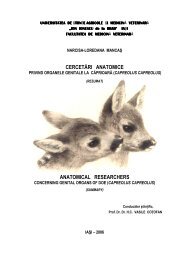
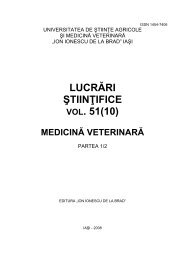

![rezumat teză [RO]](https://img.yumpu.com/19764796/1/190x245/rezumat-teza-ro.jpg?quality=85)
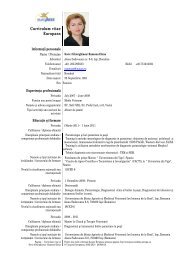



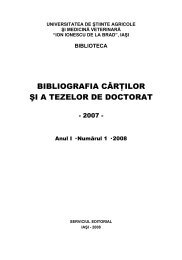
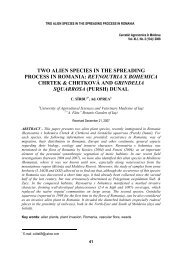
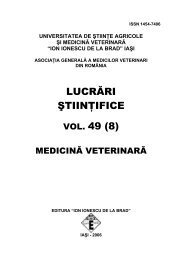
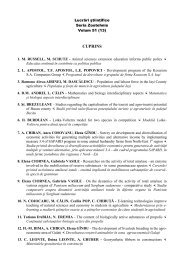
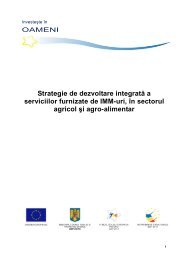
![rezumat teză [RO] - Ion Ionescu de la Brad](https://img.yumpu.com/14613555/1/184x260/rezumat-teza-ro-ion-ionescu-de-la-brad.jpg?quality=85)
